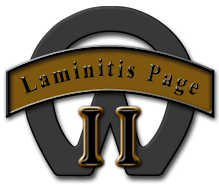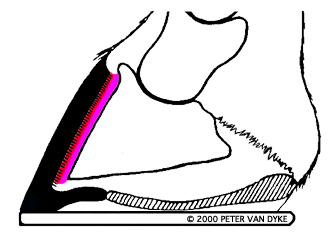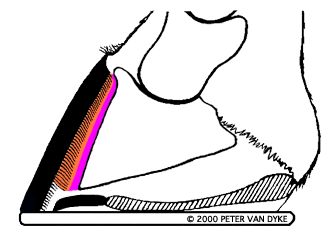
|
|
What is laminitis?
|
|
In the illustration the black arrow points to the end of a primary epidermal lamina or lamella. The red arrow points to the end of a primary dermal lamina or lamella. The epidermal laminae may also be called insensitive laminae or non living laminae. The dermal laminae may also be called sensitive laminae or living laminae. The dermal laminae are connected to the surface of P3 by connective tissue. The epidermal laminae are part of the inner surface of the hoof wall. These two interdigitating structures form the lamellar bond, the connection between the hoof and the bone.
When swelling occurs in the lamellar space, fluids normally present (blood, etc.) are displaced by the introduction of edematous fluids (swelling). Because the lamellar space has a fixed fluid volume and is unable to expand, swelling (edema) compresses blood vessels and nerves in the lamellar space, compromising local blood flow and causing considerable pain for the horse. When blood supply is restricted to the sensitive laminae they are at risk of losing normal function or death.
Founder
Because the lamellar space in the heel region is NOT similarly restricted in its capacity to expand (lateral cartilage, thinner shorter hoof wall, etc.) the lamellar bond is here faces a lesser challenge. For this reason, and others, when the lamellar bond is finally destroyed in the toe region "rotation" is produced. The heels maintain their bond while the toe does not. The sensitive laminae, now devoid of blood (orange area above) have stretched. It is important to understand that the swelling taking place is of an hydraulic nature. Resistance is futile. The dorsal aspect of P3 will be forced apart from the hoof wall at the toe by hydraulic pressure alone. Neither gravity nor deep digital flexor tendon tension are REQUIRED to produce rotation. Nor will sustained P3 support without resection offer comfort.
A problem with terminology arises here
As non inflammatory processes that affect the hoof/bone bond become better understood we expect that this will impact the use of the term founder, more so than the term laminitis. Laminitis, the inflammatory condition, is around to stay. But founder, now so closely associated with laminitis, will likely be shown to have non-inflammatory influences either precipitating or contributing significantly to it. We anticipate the addition of new terms which will describe these conditions more accurately. It is our hope that each new term and description will serve to clarify the horse owner's understanding of "laminitis" rather than to further confuse and confound. We are concerned, however, that new terms and descriptions of obscure conditions affecting the hoof/bone bond may eclipse descriptions of diseases more likely to effect the general horse population. The laminitis most familiar to horse owners will not simply disappear in light of newly discovered hoof pathologies. We expect that the reason why some horses "sink" rather than "rotate" is likely to be explained by these new findings. We prefer to think in terms of hoof/bone bond disease. Currently we identify three hoof/bond disease categories, by location (or tissue type). Horny (White Line Disease, Seedy Toe, etc.), lamellar (inflammatory and non inflammatory), connective tissue (inflammatory and non inflammatory). Each of these, of course, have their own etiology. It is not our intention to diminish the importance of understanding the particular pathology affecting an individual horse. However, we do want to demonstrate an effective therapy for ALL the conditions threatening the hoof/bone bond, regardless of their pathogenesis. This therapy consists of the application of hardware (some form of "shoe") providing alternate boney column support and the removal of the diseased tissues, collectively referred to as the Chapman Procedure.
© Copyright MMII Peter Van Dyke
|
 The word laminitis is the combination of "lamina" and "itis". Lamina refers to a thin plate like or leaf like structure, while itis means inflammation of. Laminitis means inflammation of the laminae.
The word laminitis is the combination of "lamina" and "itis". Lamina refers to a thin plate like or leaf like structure, while itis means inflammation of. Laminitis means inflammation of the laminae.
 Laminitis refers to inflammation of the laminae. Inflammation (a localized protective reaction of tissue to irritation, injury, or infection, characterized by pain, redness, swelling, and sometimes loss of function) of the laminae is of particular interest to horse owners because excessive swelling of lamellar tissues can produce very unwanted results. The laminae (red layer at right) and connective tissue (purple layer at right), two highly vascular and innervated tissue types, occupy the lamellar space. This is the area between the bone and the hoof wall, both non yielding structures. The lamellar space has a fixed fluid volume. Only so much swelling can be accommodated within the lamellar space without causing significant pain and possible tissue damage.
Laminitis refers to inflammation of the laminae. Inflammation (a localized protective reaction of tissue to irritation, injury, or infection, characterized by pain, redness, swelling, and sometimes loss of function) of the laminae is of particular interest to horse owners because excessive swelling of lamellar tissues can produce very unwanted results. The laminae (red layer at right) and connective tissue (purple layer at right), two highly vascular and innervated tissue types, occupy the lamellar space. This is the area between the bone and the hoof wall, both non yielding structures. The lamellar space has a fixed fluid volume. Only so much swelling can be accommodated within the lamellar space without causing significant pain and possible tissue damage.
 When the capacity to accommodate swelling (expansion) is exceeded, lamellar tissues begin to stretch and die. The combination of excessive expansion (hydraulic pressure forcing P3 and the hoof wall apart) and the failing lamellar bond allows (requires) the displacement (rotation or sinking) of P3.
When the capacity to accommodate swelling (expansion) is exceeded, lamellar tissues begin to stretch and die. The combination of excessive expansion (hydraulic pressure forcing P3 and the hoof wall apart) and the failing lamellar bond allows (requires) the displacement (rotation or sinking) of P3.
